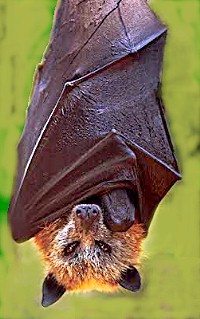Laurasiatheria
| Laurasiatheria Temporal range: Late Cretaceous - Recent
| |
|---|---|

| |
| Giant golden-crowned flying fox (Acerodon jubatus) | |
| Scientific classification | |
| Kingdom: | |
| Class: | |
| Infraclass: | |
| Superorder: | Laurasiatheria Gill, 1872
|
| Orders | |
Laurasiatheria is a clade of rank cohort or magnorder (although it is ranked super-order in traditional Linnaean taxonomy), within the Placentalia (living) or Eutheria (Placentals and their extinct ancestors) infraclass of mammals. The Laurasiatheria clade is based on DNA sequence analyses and Retrotransposon presence/absence data. The name comes from the theory that these mammals evolved on the supercontinent of Laurasia, after it split from Gondwana when Pangaea broke up. It is a sister group to Euarchontoglires (Supraprimates) and Afrotheria. It includes the following extant orders:
- Erinaceomorpha: hedgehogs and gymnures
- Soricomorpha: moles, shrews, solenodons (cosmopolitan)
- Cetartiodactyla: cosmopolitan; includes former orders Cetacea (whales, dolphins and porpoises) and Artiodactyla (even-toed ungulates, including pigs, hippopotamus, camels, giraffe, deer, antelope, cattle, sheep, goats)
- Pegasoferae:
- Pholidota: pangolins or scaly anteaters (Africa, South Asia)
- Chiroptera: bats (cosmopolitan)
- Carnivora: carnivores (cosmopolitan)
- Perissodactyla: odd-toed ungulates
Within the Laurasiatheria, the Erinaceomorpha appears (surprisingly[clarification needed]) to be the most divergent branch. Some studies link the Perissodactyla and Ferae in a clade Zooamata; others link Perissodactyla and Cetartiodactyla in a clade of true ungulates. Neither clade is well supported.
Laurasiatheria is also posited to include several extinct orders and superorders:
Template:Laurasiatheria Cladogram
References
This article includes a list of references, related reading, or external links, but its sources remain unclear because it lacks inline citations. (February 2008) |
- William J. Murphy, Eduardo Eizirik, Mark S. Springer et al., Resolution of the Early Placental Mammal Radiation Using Bayesian Phylogenetics,Science, Vol 294, Issue 5550, 2348-2351, 14 December 2001.
- Jan Ole Kriegs, Gennady Churakov, Martin Kiefmann, Ursula Jordan, Juergen Brosius, Juergen Schmitz. (2006) Retroposed Elements as Archives for the Evolutionary History of Placental Mammals. PLoS Biol 4(4): e91.[1] (pdf version)
- Kitazoe Y, Kishino H, Waddell PJ, Nakajima N, Okabayashi T, et al. (2007) "Robust Time Estimation Reconciles Views of the Antiquity of Placental Mammals." PLoS ONE 2(4): e384. doi:10.1371/journal.pone.0000384
